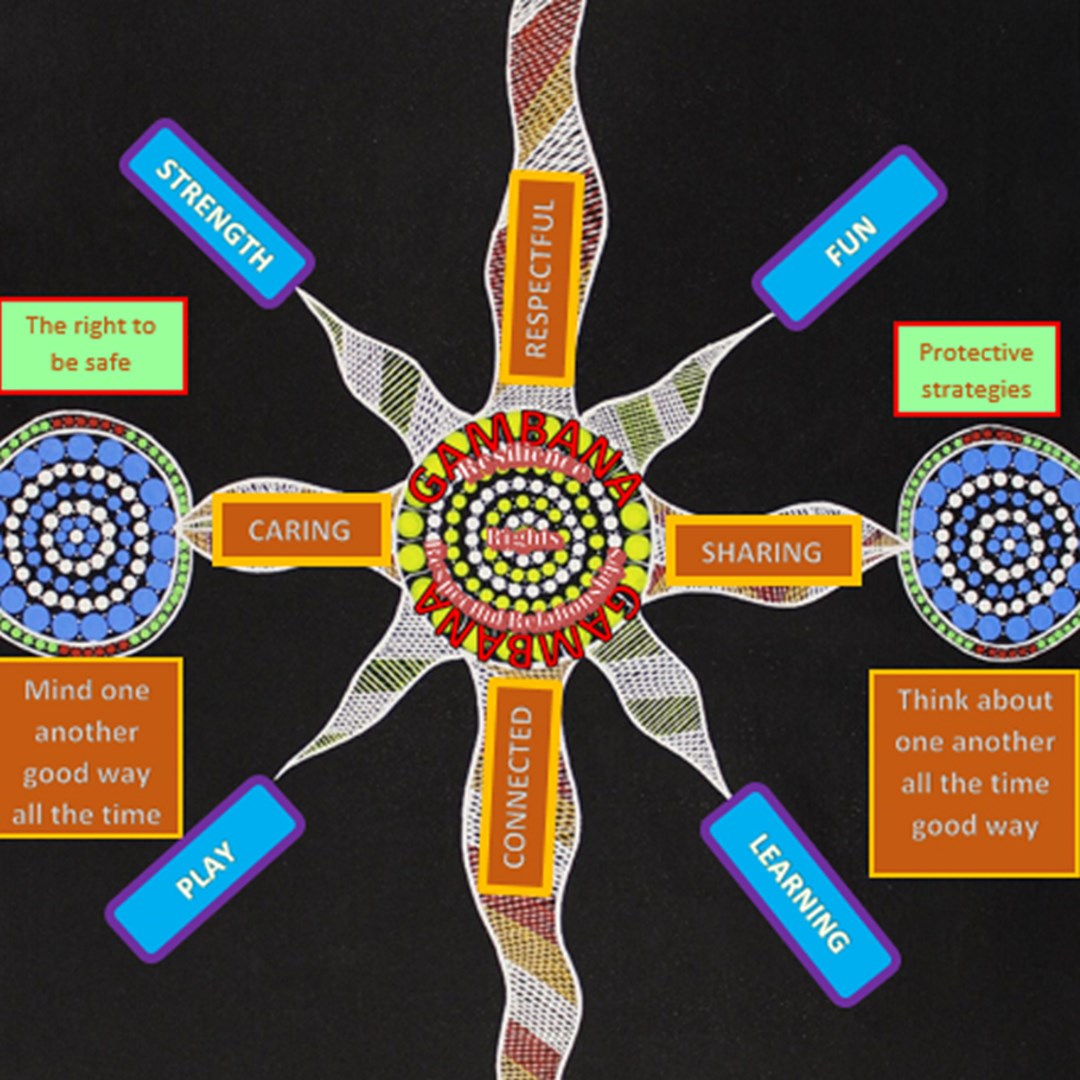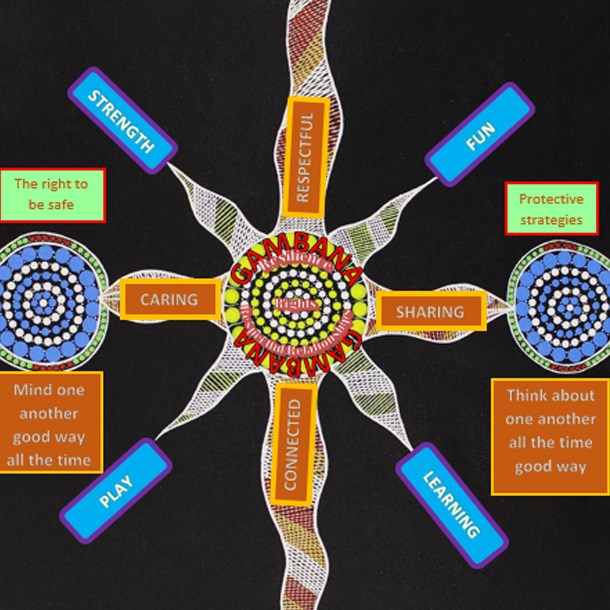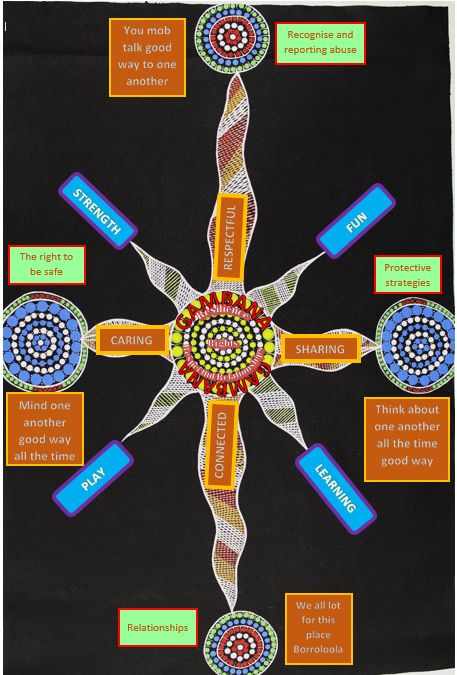
“We have two cultures going on here. We have to teach both – kids need to understand their own culture first.”
Maria Pyro, Assistant Principal and local Garrawa woman
Gambana – Walking in two worlds
Look carefully at this image. It is central to the way in which the Borroloola community of the Northern Territory is thinking about culture and the needs of their children.
The word gambana is at the centre of the process. It means ‘daytime’ in the Yanyuwa language. The shape represents the sun, or gamba in Yanyuwa.
An Aboriginal assistant teacher created the artwork on the poster. Most noticeable is the use of local idioms. “Mind one another good way all the time.” “You mob talk good way to one another.” “Think about one another all the time good way.”
Gambana represents 12 years of working together in the Borroloola community in cross-cultural ways to prepare students for their future. Gambana is an integrated philosophy of school practice for both teachers and students. It is an adaption of the Positive Behaviour for Learning with a focus on making it relevant for the local community.
Assistant Principal and local Garrawa woman Maria Pyro says of the challenge at the school: “We have two cultures going on here. We have to teach both – kids need to understand their own culture first.”
Gambana is embedded in traditional rhythms of life and nature. It was created as a response to behaviours that the community were concerned about. Maria describes the problem that confronted the community some years ago.
“We were finding that our kids were sleeping all day and out at night, walking the streets, sometimes vandalizing stuff. We wanted to go back to the Aboriginal way – to being up with the sun and resting when it’s dark. The sun is there for a reason – it enables a whole of activities like hunting, fishing, going to school. The sun is very powerful – it’s the giver of life.
We felt that we were losing our kids to Western ways and to bad Western ways. So Gambana is our way of trying to help kids walk in two worlds.
The underlying principles of Gambana include the use of Aboriginal English, that they don’t do “nobodying” and that staff aim to be positive and proactive rather than punitive.
Take a look at how the students at the school are walking in two worlds via the video Borroloola - We Alright! This 2019 production from Indigenous Hip Hop Projects was developed with Borroloola students.
Good way…
Resilience, Rights and Respectful Relationships sits at the centre of the Gambana but the messaging is adapted to the local context.
“Good way” is a term used by all teachers to note the process of being respectful. The phrase “You mob talk good way to one another” is used to intervene in arguments and to encourage the sharing practices that have been part of the local cultures for thousands of years. Maria says:
There are still fights. Kids are kids – it’s inevitable. But now, we stop the lesson and go to the ideas of Gambana. It refreshes, re-energises the kids.”
She continues:
The school’s vision is – two cultures, two-way learning. For years we struggled with how to do this but around 8 years ago, things changed. Now it’s the teachers and Principal all working together - things are much better.
Greater inclusion of indigenous staff members has made a big difference. There is commitment to the Gambana model and there are clear processes if students are misbehaving. There is respect between Indigenous and non-Indigenous staff. Assistant Teacher Daphne Mawson says of this:
White people can’t solve an Aboriginal problem, but we have to try to walk together, to balance things out with the students. When new teachers arrive, we have an induction. We show them the community, drive around, take them to significant places. We had a professional development day to teach them a bit about our ways, about bush tucker, the dreamtime.
Aboriginal assistant teachers play a pivotal role in bridging cultures between teachers and students. Daphne says:
We walk in two worlds. We do it daily. We help non-aboriginal teachers to teach both ways. To use local language. We provide scaffolding that helps kids when they don’t understand what the teachers are saying. It happens a lot.
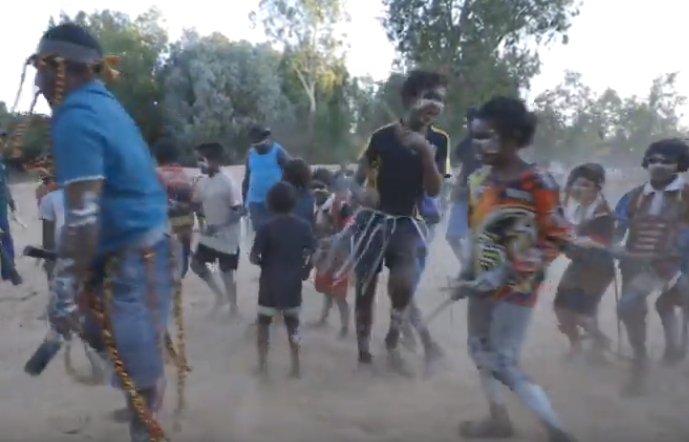
“White people can’t solve an Aboriginal problem, but we have to try to walk together, to balance things out with the students."
Daphne Mawson, Assistant Teacher
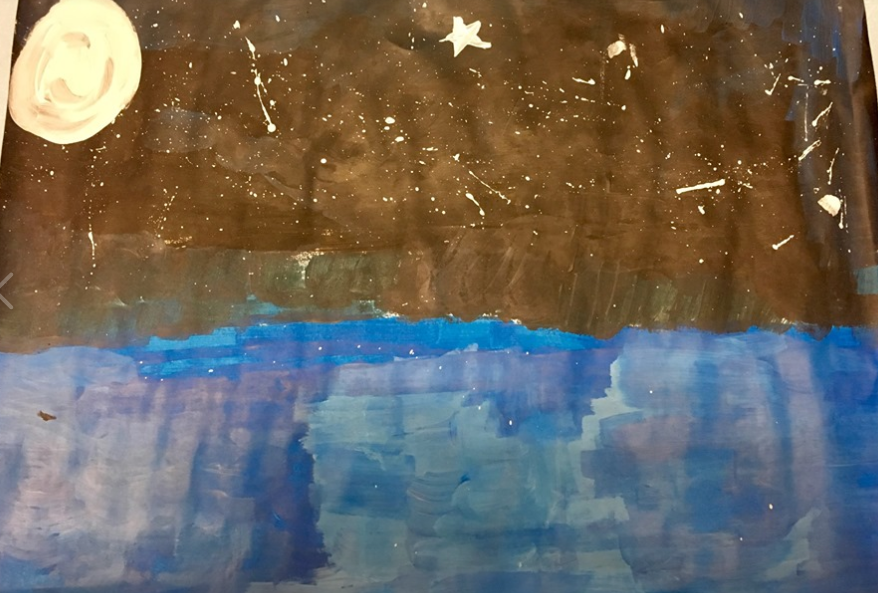
The school is working hard to ensure that there is a sense of ownership and connection between home and school.
Working with families
Noela Anderson has been working in the school for 20 years. Her role is in liaison with families. She has noticed a decline in family support in the last two decades. This is one reason the school is working hard to ensure that there is a sense of ownership and connection between home and school. Noela explains by way of comparison:
Lots of families have been Westernised – they think that school matters should stay at school. But we want this to change. As an example – there was a bad school break-in some years ago. We decided to bring the community in to look at the damage. The whole community was there, and elders and families, the school staff. We said “the school is sacred ground".
This place Borroloola
“We all lot for this place Borroloola” promotes inclusion of the diverse population in the town – which includes Maori families, non-indigenous families and the four Aboriginal groups that have traditionally occupied the region. The school itself has a 95% Indigenous population, including students and staff representing the four Aboriginal language groups, Yanyuwa, Garrawa, Marra and Gudanji. The school runs camps and activities out on country where elders teach about the local environment, about bush tucker, medicine and the story lines that are part of the four Aboriginal groups that comprise the area. At night there is traditional dancing; a strategy to convince students that it is possible to have fun without Wi Fi (Yes – it’s a challenge!) The school’s Facebook page is a living chronology of the types of events and learning activities that are available in the school.
Local language is used around the school and in structures such as the naming of each class: ‘Wardawiji’ is the transition class for example, and in the sports houses of the school.
Visuals
Visual messaging forms a really strong part of the school’s focus with positive signs, use of Aboriginal words and school uniforms designed, by a local teacher, to reflect the interaction of cultures.
The school has adapted the learning materials in the Northern Territory Social and Emotional Learning materials. Adaptations have been made to integrate the Gambana approach and imagery, and to include the language that Borroloola students would naturally use when they are feeling specific emotions.
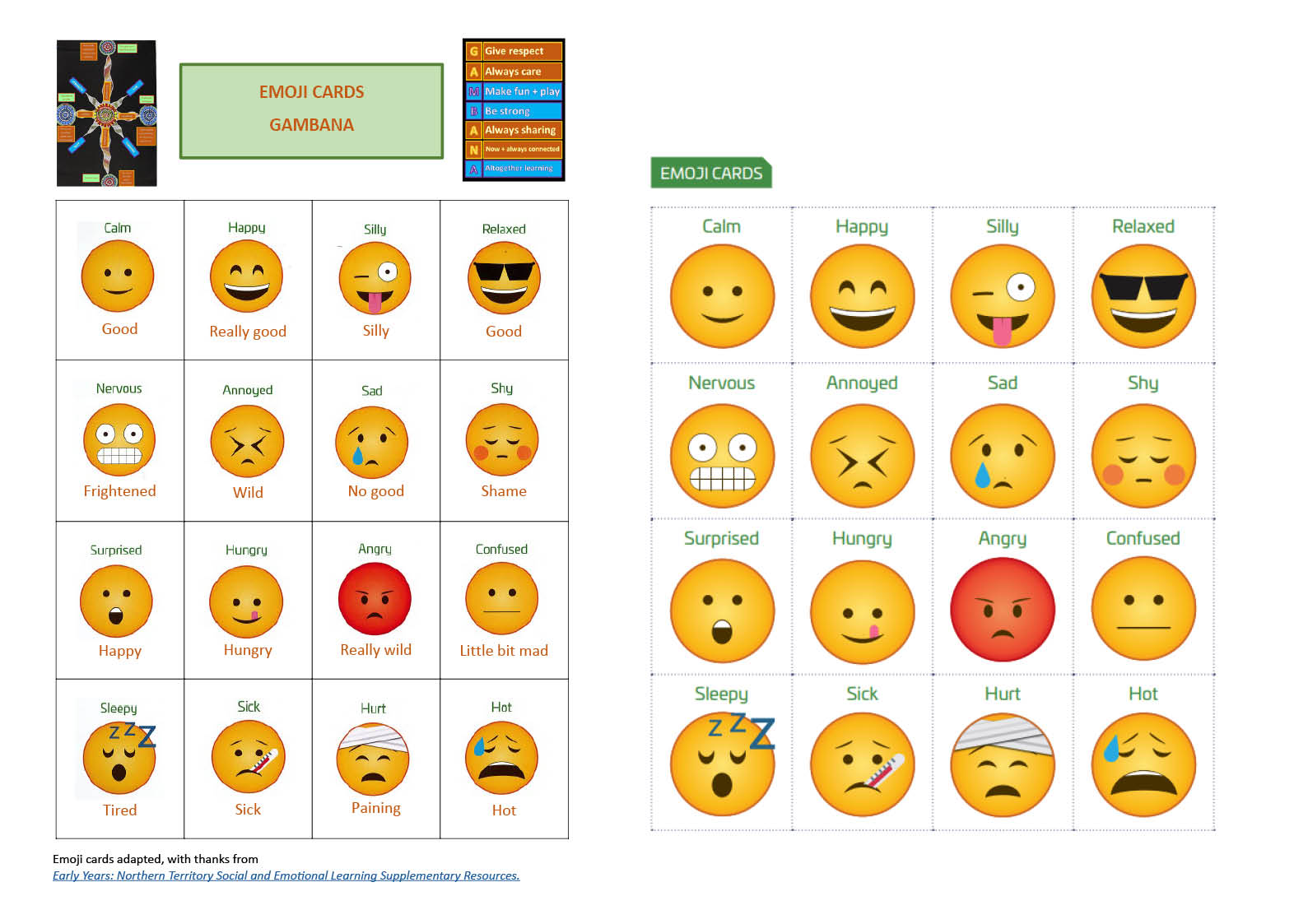
Download:
- Feelings chart: Borroloola Adaptation
- Emoji Cards: Borroloola Adaptation
- Northern Territory Social and Emotional Learning Early Years Supplementary Resources: Transition – Year 2
- Northern Territory Social and Emotional Learning Early Years Supplementary Resources: Year 3 – Year 6
- Northern Territory Social and Emotional Learning Early Years Supplementary Resources: Middle Years
- Northern Territory Social and Emotional Learning Early Years Supplementary Resources: Year 10 – 12
Emoji cards adapted from Early Years: Northern Territory Social and Emotional Learning Supplementary Resources.
Teaching about sexual health and relationships
Sexual health and relationship education includes a particular set of considerations in communities such as Borrolooola and more widely throughout the Northern Territory. Understanding the kinship structure is part of understanding how people relate to each other. Some topics are explored via separate camps for girls and for boys. Educator awareness of customary practices related to greetings, to personal space, to eye contact and other modes of communication is important in effective delivery of this type of curriculum. (For some additional advice about these topics, see the Remote Area Health Corps Cultural Orientation Handbook.)
The Respectful Relationships curriculum in the Northern Territory is based on the Resilience, Rights and Respectful Relationships materials with the addition of Northern Territory Social and Emotional Learning materials.
Teaching about Respectful Relationships requires specific skills on the part of the teachers. Borroloola teachers use local idioms such as “good way” and must be conscious of their non-verbal communication, including body language and facial expressions. Visual aids make a big difference. Listening is important. Daphne Mawson says:
“It’s taken time, but we’ve worked it out with the teachers. They might not get an answer back straight away. Kids need time to stop and think."
Extended pauses give Aboriginal students time to think about questions and perhaps to translate what has been said into their own languages.

The Northern Territory Social and Emotional Learning (NT SEL Implementation Guide includes the following advice for teachers:
Culture, is a starting point for social and emotional wellbeing. For this reason, NT SEL combines personal and social capability with intercultural understanding to respect community feedback and support students to thrive in the uniquely multicultural context of the Northern Territory. Gender and kinship dynamics should be considered before asking students to participate in group discussion or activities. Educators can ask their principal about who is best placed to help collaborate in culturally responsive planning ahead of time.
In practice, this includes, amongst ten dot points:
- being aware, respectfully inquisitive and becoming educated in cultural beliefs and practices of the people around you
- seeking advice from local staff or community members about language, body language and social and emotional skills that are learned by students outside the classroom
- understanding that different cultures recognise different skills as strengths, and therefore students are likely to have strong skills in a variety of areas. These skills should be acknowledged as important strengths, and
- sharing power relationships between home, school and community.
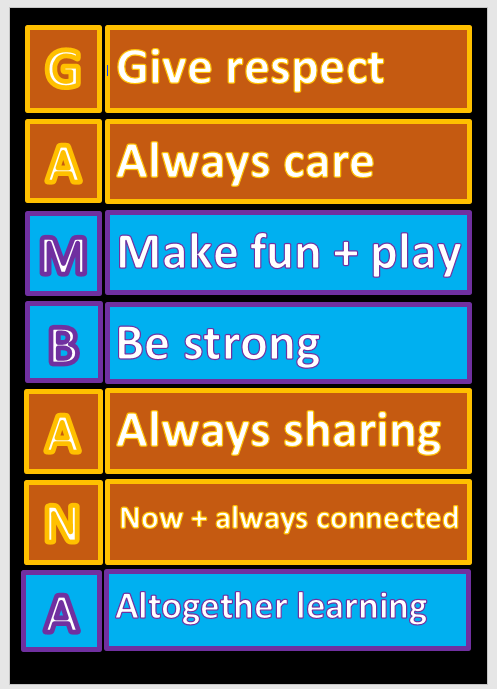
Teachers
The teaching staff at the school has been relatively stable over the past few years. Principal, Stephen Pelizzo reflected recently on the specific nature of the work in a community like Borroloola.
Not many people can or do work in this rather complex environment, fewer still last any length of time, or seem truly adapted to it. I often tell my staff, with pride, that we are on the sharp pointy bit of education in Australia. I tell them that safe and normal schools exist in urban centres and in other parts of our nation, where teachers work hard and with talent and succeed in Literacy and Numeracy. Here they have far greater challenges, and do work that is far more important than simply that.
Stephen Pelizzo says that the approach is continuing to evolve.


